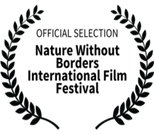AUDIOQUATROSCOPY
An Audioquatroscopy is a new type of experimental short film, in which image movements are linked to the rhythm of a well-known classical music piece. A quatroscope is a four-sided mirror tunnel, similar to a kaleidoscope, but built of four, rather than three mirrors. A square image placed at one end - when observed from the other end of the tunnel - is reflected repeatedly in four directions, leading to unexpected and fascinating patterns, which change, when the central image is moved.
The audioquatroscopy, that best illustrates some basics about the optical behaviour of a single square image is: Gershwin and Love.
An optical peculiarity is: When a square is rotated, empty spaces at the corners emerge. In my quatroscopies these spaces are filled by mirroring the image along the boundaries of the square.
Current News:




As of September 9th 2025 I have received my first Award at the Bollywood USA International Film Festival 2025 for my AUDIOQUATROSCOPY Warmer Summers since Vivaldi (see: https://youtu.be/sCmB5Bzwr3s)
At the Red Movie Awards 2025 in Reims my AUDIOQUATROSCOPY Arc de Triomphe & Chopin was chosen for an Excellence Director Selection Award (see: https://youtu.be/Cn12_-emaJw)
Two more are currently at the Semi-Finalist and Finalist level
For the creation of Audioquatroscopies I link any digital image to an available licence-free music piece. Currently I group the existing and published Audioquatroscopies into the following four themes.
Fine Arts
Grieg and Mondrian https://youtu.be/_cierciBATE
Saint-Saëns and van Gogh https://youtu.be/QbXMtGdT1D0
Koller and Haydn https://youtu.be/Gdfe9er8dvg
Brahms and Klimt https://youtu.be/rjVb2fdvJMs
Chopin and Niki's Nana https://youtu.be/K1YMmpjnKdw
Palestrina and Isenheimer Altar https://youtu.be/PYy3giWozfo
POP and Lichtenstein https://youtu.be/UJ9VUPd_PYg
Nature
Debussy and Lunar Rock Thinsection https://youtu.be/DGydnO8uLc0
Satie and Butterfly https://youtu.be/z6IPnvnR4KI
Charpentier and Matterhorn https://youtu.be/epaVJ9NHnfc
Vivaldi and Gobal Warming https://youtu.be/sCmB5Bzwr3s
Mahler and Stellar Nursery https://youtu.be/xL7az2l-J_s
Vivaldi and Plankton Bloom https://youtu.be/6jCnN_nSGlY
Landmarks found in Google World
Bach and Zürich Old Town https://www.youtu.be/v=b-wj0r5-a7c
Händel and Westminster Abbey https://www.youtu.be/iiDglw_2SmI
Chopin and Arc de Triomphe https://youtu.be/Cn12_-emaJw
Scarlatti and Venice https://youtu.be/Uf28x9PPAAU
Händel and Zürich Oldtown https://youtu.be/b-wj0r5-a7c
Bach and St. Thomas Church https://youtu.be/zrDb3qDkBW8
Bartok and Basler Münster https://youtu.be/l11g6XakV0o
Mozart in Vienna https://youtu.be/bqM3r5SWoc4
Artefacts
Gershwin and LOVE https://youtu.be/C7_mCAMmiqQ
Schuhmann and Grandma's Blanket https://youtu.be/O4haqVqYvxM
How I got to producing audioquatroscopies
Audioquatroscopy evolved from my previous work on quatroscopes. In a quatroscopy a single square image is repeatedly reflected in four directions, leading to a mosaic-like pattern. In reality, a quatroscope is a long mirror tunnel, consisting of four rather then three elongated mirrors, such as in most traditional kaleidoscopes. My first quatroscopies were produced in 2014 using a 5x5 cm square, 33 cm long mirror tunnel, placed in front of a computer-screen. Images were moved on that screen until an aesthetically pleasing pattern emerged, that could be recorded with a camera.

The quality of the pictures taken with a camera was, however rather poor. Consequently quatroscopies were produced digitally from input images using Photoshop, such as this quatroscopy of Niki de Saint Phalle's Nana:

